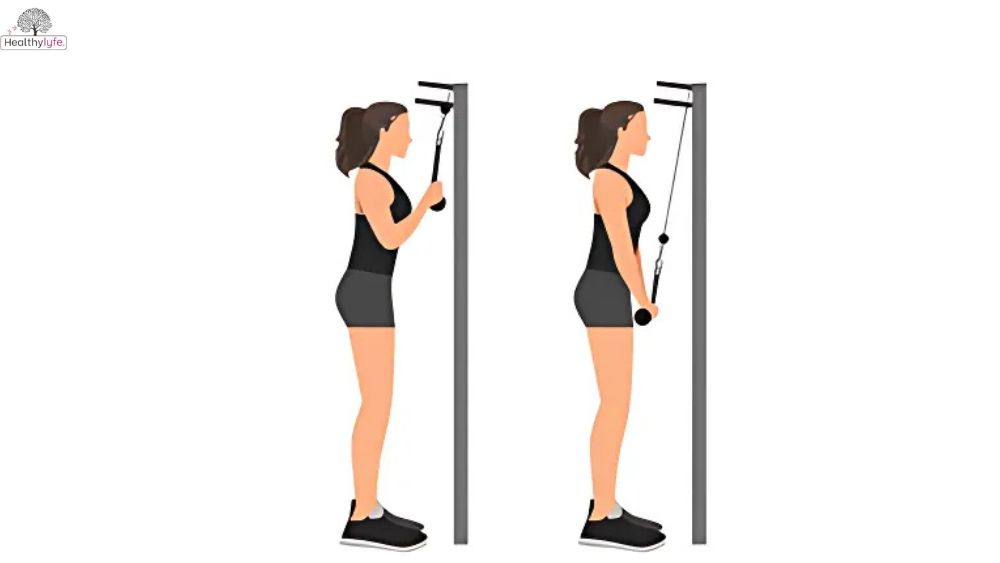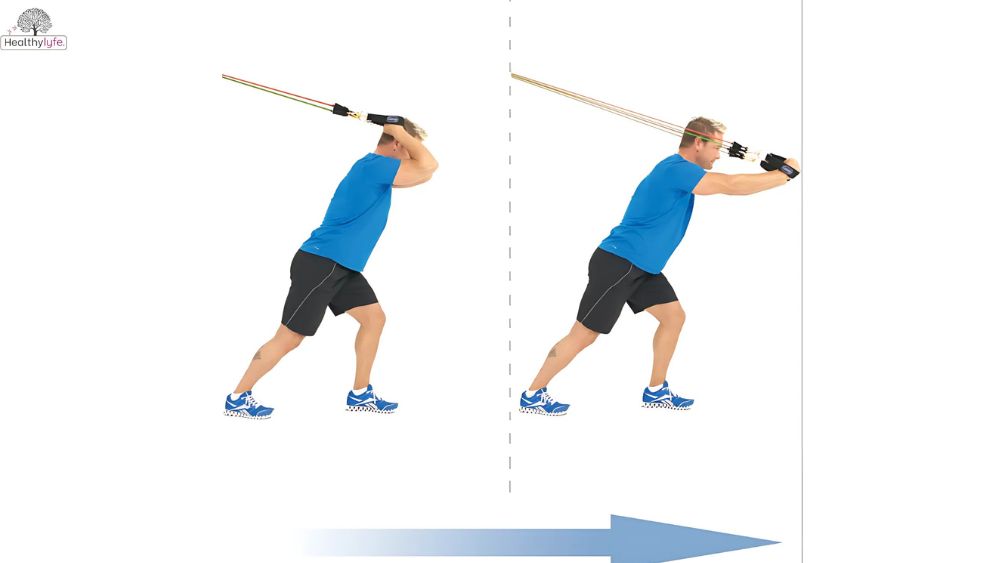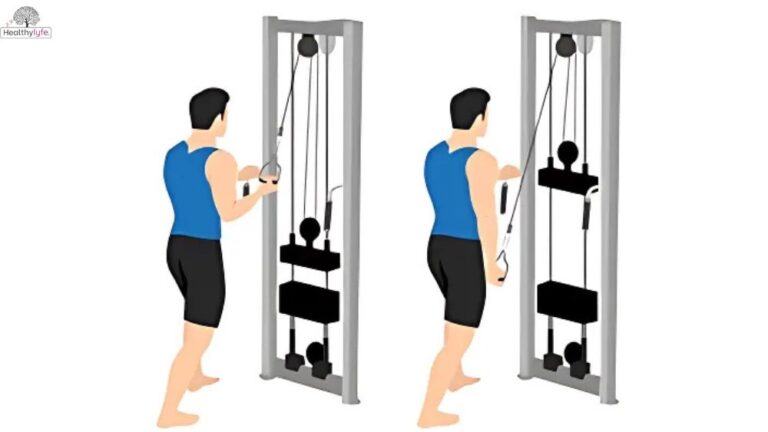Pushdown: Best Exercise For Muscle and Triceps
Learn all about the pushdown exercise, its benefits for building triceps, variations to challenge your muscles, and the ideal diet plan to fuel your workouts
Introduction
The pushdown exercise is a popular triceps workout that helps build strength and definition in the upper arms. It is usually performed on a cable machine using different attachments like a rope, straight bar, or V-bar. This exercise is great for improving arm muscles and supporting other upper-body workouts like bench presses and overhead lifts.
To get the best results, combine pushdowns with a protein-rich diet for muscle growth. There are also different variations of this exercise to target the triceps in different ways.
What is Pushdown Exercise?
The pushdown exercise is a strength-training move that targets the triceps—the muscles at the back of your upper arms. It is typically performed using a cable machine with attachments like a rope, straight bar, or V-bar. This exercise helps build arm strength, improve muscle definition, and enhance overall upper-body performance.
Pushdowns are commonly used in fitness routines to support pressing movements like bench presses and overhead lifts. They are easy to perform and can be modified with different grips and equipment to challenge the muscles in various ways.
How to Do Pushdown Exercise
The pushdown exercise is a simple yet effective move to strengthen and tone your triceps. Follow these steps to perform it correctly:
Step-by-Step Guide
- Set Up the Machine – Attach a rope, straight bar, or V-bar to the cable machine at chest height. Adjust the weight to a manageable level.
- Grip the Handle – Stand with feet shoulder-width apart and grasp the attachment with an overhand grip (palms facing down).
- Position Your Body – Keep your elbows close to your sides, maintain a slight forward lean, and engage your core for stability.
- Push Down – Extend your arms downward until they are fully straight, squeezing your triceps at the bottom.
- Controlled Return – Slowly bring the attachment back up to the starting position without letting your elbows flare out.
- Repeat – Perform 10–15 reps for 3–4 sets, depending on your fitness level.
Variations of the Pushdown Exercise [1]
The pushdown is a staple in triceps training because it isolates the muscle and allows for controlled resistance throughout the movement. It involves extending the arms downward against resistance while keeping the elbows stationary. This exercise helps improve arm strength, aids in pressing movements, and enhances overall upper body conditioning.
There are several variations of the pushdown that modify grip, attachment, or stance to target the triceps differently:

- Straight Bar Pushdown – Uses a straight bar attachment for balanced force distribution.
- Rope Pushdown – Engages more of the triceps’ lateral head due to the increased range of motion.
- V-Bar Pushdown – Allows for a stronger grip and greater resistance, targeting all three heads of the triceps.
- Reverse-Grip Pushdown – Uses an underhand grip, placing more emphasis on the medial head of the triceps.
- Single-Arm Pushdown – Increases focus on each arm individually, improving muscle symmetry.
- Resistance Band Pushdown – A portable variation that mimics the cable movement using resistance bands.
Benefits of Pushdown Exercise
The pushdown exercise is a strength-training movement that primarily targets the triceps—the muscles located at the back of your upper arms. It is commonly performed using a cable machine with a straight bar, V-bar, or rope attachment. This exercise is popular among athletes, bodybuilders, and fitness enthusiasts due to its effectiveness in building arm strength and definition.
Stronger and More Defined Triceps
- Pushdowns isolate the triceps, helping to develop muscle size, shape, and endurance.
- Well-defined triceps contribute to a balanced and aesthetic arm appearance.
Improves Arm Strength for Other Exercises
- Stronger triceps support pressing movements like bench presses, overhead presses, and dips.
- Helps improve performance in sports and daily activities that involve pushing motions.
Enhances Joint and Elbow Stability
- Strengthening the triceps reduces stress on the elbow joint.
- Helps prevent elbow pain and injuries by improving muscular support around the joint.
Versatile and Beginner-Friendly
- Can be done with various attachments (rope, straight bar, or V-bar) to target different parts of the triceps.
- Easy to learn and can be adjusted to suit beginners and advanced lifters.
Increases Overall Upper Body Strength
- Contributes to a stronger and more powerful upper body.
- Supports compound exercises that engage multiple muscle groups.
Enhances Muscle Endurance
- Higher reps with lighter weights improve muscular endurance, beneficial for athletes and functional fitness.
Can Be Performed in Different Variations
- Reverse-grip pushdowns target different areas of the triceps.
- Single-arm pushdowns help fix muscular imbalances.
Diet Plan for Pushdown Exercise
The triceps pushdown is an effective isolation exercise targeting the triceps brachii, which helps in arm strength and definition. It is commonly performed using a cable machine with a straight bar, rope, or V-bar attachment.
To maximize the benefits of this exercise, a balanced diet plan is essential for muscle growth, recovery, and energy levels. A proper diet should include:
- Protein for muscle repair and growth
- Carbohydrates for energy
- Healthy fats for overall muscle function
- Hydration to maintain performance and recovery
Diet Plan Table for Triceps Pushdown Workout:
| Meal | Food Options | Nutritional Benefits |
|---|---|---|
| Pre-Workout (30-60 min before) | – Oatmeal with banana & peanut butter – Whole grain toast with eggs – Greek yogurt with berries & nuts | Provides sustained energy and prevents muscle breakdown |
| Post-Workout (Within 30 min after) | – Grilled chicken with quinoa & steamed veggies – Protein smoothie (whey protein, banana, almond milk) – Salmon with brown rice & spinach | Supports muscle recovery and growth |
| Breakfast | – Scrambled eggs with whole wheat toast & avocado – Cottage cheese with honey & almonds – Protein pancakes with berries | High in protein and healthy fats for muscle maintenance |
| Lunch | – Grilled lean meat (chicken/beef) with sweet potatoes & greens – Tuna salad with whole grain bread – Quinoa & lentil bowl with veggies | Balanced mix of protein, carbs, and fiber |
| Dinner | – Baked fish with brown rice & steamed vegetables – Turkey breast with quinoa & roasted carrots – Stir-fry tofu with veggies & jasmine rice | Provides sustained muscle recovery overnight |
| Snacks (Anytime) | – Almonds, walnuts, or mixed nuts – Protein bar or shake – Hummus with whole wheat crackers – Boiled eggs | Maintains muscle-building nutrients throughout the day |
Additional Tips for Muscle Growth & Recovery:
- Hydration: Drink at least 2.5-3 liters of water daily.
- Protein Intake: Consume 1.2-2.0g of protein per kg of body weight.
- Healthy Fats: Include sources like avocados, nuts, and olive oil.
- Consistency: Stick to your workout and diet plan for visible results.
Common Mistakes to Avoid
Mistakes are a natural part of learning and growth, but some errors can slow down progress, cause frustration, or lead to negative consequences. By understanding common mistakes in different areas of life—whether in school, work, relationships, or personal development—you can take steps to avoid them. This guide outlines some of the most frequent mistakes people make and how to prevent them.
Common Mistakes and How to Avoid Them:

- Lack of Planning – Jumping into tasks without a clear plan often leads to wasted time and errors. Solution: Take time to organize your thoughts, set goals, and outline a strategy before getting started.
- Procrastination – Putting off important tasks can result in missed deadlines and unnecessary stress. Solution: Break tasks into smaller steps and set deadlines to stay on track.
- Ignoring Feedback – Dismissing constructive criticism prevents improvement. Solution: Listen carefully, consider feedback, and use it to grow.
- Overcommitting – Taking on too many responsibilities can lead to exhaustion and decreased effectiveness. Solution: Learn to say no and prioritize tasks wisely.
- Poor Communication – Lack of clear communication can cause misunderstandings in both personal and professional relationships. Solution: Be direct, clear, and open when expressing thoughts and expectations.
- Not Asking for Help – Trying to do everything alone can be overwhelming and unproductive. Solution: Seek support when needed and collaborate with others.
- Neglecting Health and Well-being – Ignoring physical or mental health can have serious long-term effects. Solution: Maintain a balanced diet, exercise regularly, and take breaks to recharge.
- Fear of Failure – Avoiding challenges out of fear can limit opportunities for success. Solution: View failures as learning experiences and take calculated risks.
Tips for Success
Success is a journey that requires dedication, planning, and continuous learning. Whether you’re aiming for personal growth, academic excellence, or career advancement, implementing effective strategies can make a significant difference. Here’s a brief guide to help you set the foundation for success.
Key Tips for Success:
- Set Clear Goals – Define what success looks like for you. Establish short-term and long-term goals that are specific, measurable, achievable, relevant, and time-bound (SMART).
- Stay Organized – Use planners, to-do lists, or digital tools to manage your tasks efficiently. Prioritizing your work helps reduce stress and enhances productivity.
- Develop a Growth Mindset – Embrace challenges as learning opportunities. Be open to feedback and continuously seek ways to improve yourself.
- Manage Your Time Wisely – Avoid procrastination by breaking tasks into smaller steps and setting deadlines. Time management skills are crucial for maintaining balance and efficiency.
- Build Strong Habits – Consistency is key to long-term success. Establish daily routines that align with your goals, such as reading, exercising, or networking.
- Stay Motivated and Resilient – Success often involves setbacks. Stay persistent, learn from failures, and keep pushing forward despite obstacles.
- Surround Yourself with Positivity – Engage with people who support and inspire you. A strong network of mentors, friends, and colleagues can provide valuable insights and encouragement.
- Invest in Continuous Learning – Stay curious and keep updating your knowledge. Reading books, taking courses, and learning new skills will keep you competitive and adaptable.
- Take Care of Your Health – Physical and mental well-being play a vital role in success. Maintain a balanced diet, exercise regularly, and practice self-care to keep your energy levels high.
- Take Action – Planning is important, but execution is what brings results. Avoid overthinking and start taking steps toward your goals today.
Conclusion
The pushdown exercise is one of the best moves for building strong, defined triceps. It improves arm strength, enhances muscle tone, and supports better performance in pressing movements. To maximize results, follow a balanced diet rich in lean protein (chicken, fish, tofu), healthy carbs (quinoa, brown rice), and good fats (avocados, nuts). Staying hydrated and eating according to your fitness goals—whether muscle gain or fat loss—will boost your progress. For variety, try different pushdown variations like rope pushdowns, straight bar pushdowns, and reverse grip pushdowns to target different parts of the triceps and prevent workout plateaus.
FAQs About Pushdown Exercise
What is a pushdown exercise?
A strength-training exercise that targets the triceps using a cable machine or resistance bands.
Which muscles do pushdowns work?
Primarily the triceps, but they also engage the shoulders and forearms for stability.
Are pushdowns good for beginners?
Yes, they are easy to learn and a great way to build triceps strength.
How often should I do pushdowns?
Two to three times a week, depending on your workout routine and recovery.
Can I do pushdowns every day?
It’s best to allow at least 48 hours of rest between triceps workouts for muscle recovery.
What are the benefits of pushdowns?
They help build stronger, more defined triceps, improve arm endurance, and enhance pushing strength.
Do pushdowns help with bigger arms?
Yes, they contribute to overall arm size by strengthening and toning the triceps.
Are pushdowns good for sports performance?
Yes, they improve pushing strength, which benefits sports like boxing, basketball, and football.
Can pushdowns reduce arm fat?
While they build muscle, fat loss requires a combination of exercise and a calorie-controlled diet.
Do pushdowns improve bench press performance?
Yes, stronger triceps contribute to better bench press and other pressing movements.
What are some pushdown variations?
It depends on your goal—rope pushdowns activate more muscle fibers, while reverse grip targets the long head of the triceps.
Can I do pushdowns without a cable machine?
Yes, you can use resistance bands or dumbbell kickbacks as alternatives.
Are rope pushdowns better than straight bar pushdowns?
Rope pushdowns allow a better range of motion and more triceps activation.
Should I use a wide or narrow grip for pushdowns?
A wider grip focuses more on the lateral triceps head, while a narrow grip emphasizes the long head.
What should I eat before doing pushdowns?
A balanced meal with protein (chicken, eggs) and carbs (oats, rice) for energy.
What foods help with triceps growth?
Lean proteins (chicken, fish, tofu), complex carbs (quinoa, sweet potatoes), and healthy fats (avocados, nuts).
How much protein do I need for muscle growth?
Around 0.7–1 gram of protein per pound of body weight, depending on your fitness goals.
Should I take supplements for triceps growth?
Protein powder, creatine, and BCAAs can help, but a well-balanced diet is most important.
How important is hydration for muscle growth?
Staying hydrated helps with muscle recovery, energy levels, and overall performance.
Disclaimer: The information provided in this article is for general informational purposes only and is not intended as medical advice. Always consult with a healthcare professional or certified fitness trainer before starting any new exercise.
By healthylyfe


